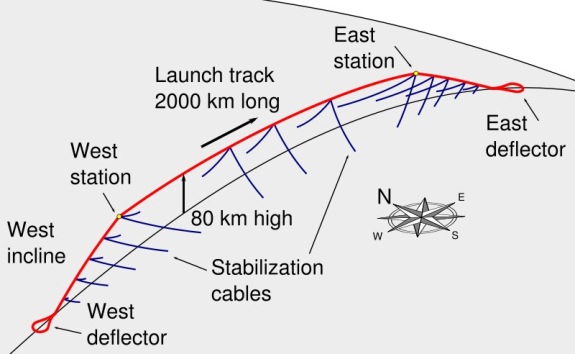Non-Rocket Spacelaunch – Advantages and Difficulties of a Launch Loop
This is the second part to the article on the launch loop from the non-rocket spacelaunch series. A complete list of all the articles in this series can be seen at the end of this post.
 A schematic of a launch loop as imagined by Lofstrom.
A schematic of a launch loop as imagined by Lofstrom.
Advantages of launch loops
Unlike conventional rockets, launch loops can have many launches per hour, independent of weather, and are not inherently polluting. Rockets create pollution such as nitrates in their exhausts due to high exhaust temperature, and can also create greenhouse gases depending on propellant choices. Launch loops require power in the form of electricity and as such it can be clean. For example it can run on geothermal, nuclear, wind, solar or any other power source, even intermittent ones, as the system has huge built-in power storage capacity. Additionally, launch loops would be quiet in operation, and would not cause any sound pollution, unlike rockets.
Launch loops are also intended for human transportation. It gives a safe 3g acceleration which the vast majority of people would be capable of tolerating well, and would be a much faster way of reaching space than space elevators.
Unlike space elevators which would have to travel through the Van Allen belts over several days, launch loop passengers can be launched to low Earth orbit, which is below the belts, or through them in a few hours. This would minimize radiation doses and keep them within safe levels.
Launch loops wouldn’t be subjected to the risks of space debris and meteorites, unlike space elevators. This is because they are to be situated at an altitude where orbits are unstable due to air drag. Therefore damage or collapse of loops in this way is expected to be extremely rare. Even if an accident does occur the consequences would be much less catastrophic than with a space elevator. If the launch loop is built over an uninhabited area such as a desert or an ocean, then there should be very little risk to human life in case of failure.
Finally, their low payload costs of about 3 USD per kg will open up large-scale commercial space tourism and even space colonization. Also the initial costs of construction of 10 billion USD are quite low compared to the other non-rocket spacelaunch methods. This is roughly equivalent to the cost of 20 space shuttle launches.
Difficulties of launch loops
A running loop would have an extremely large amount of energy in the form of linear momentum (about 1.5×1015 joules or 1.5 petajoules). If a major failure did occur the energy release would be approaching a nuclear bomb explosion (or 350 kilotons of TNT equivalent), although not emitting any nuclear radiation. This is why the magnetic suspension system of the launch loop would be highly redundant, with failures of small sections having essentially no effect at all.
Even if the safeties fail and this large amount of energy is released, it is unlikely that it would destroy very much of the structure due to its very large size. Also most of the energy would be deliberately dumped at preselected places when the failure is detected. Steps might need to be taken to lower the cable down from 80 km altitude with minimal damage, such as parachutes.
A few technical issues involving the cable’s instability problems would have to be solved before constructing a launch loop. Lofstrom’s design requires electronic control of the magnetic levitation to minimize power dissipation and to stabilize the otherwise under-damped cable.
Conclusion
In conclusion, the launch loop concept does have a few technical difficulties, but if those can be solved, the advantages of such a spacelaunch method are great. Lowering the costs of space travel and opening the final frontier to tourism and eventually colonization are just a few of them.
Links to the other articles in this series
Space Elevator:
- Non-Rocket Spacelaunch – Space Elevator
- Non-Rocket Spacelaunch – Space Elevator Safety Issues
- Non-Rocket Spacelaunch – Extraterrestrial Space Elevator Concepts
- Non-Rocket Spacelaunch – Space Elevators in Fiction
Tether Propulsion:
- Non-Rocket Spacelaunch – Tether propulsion
- Non-Rocket Spacelaunch – Tether satellite missions
- Non-Rocket Spacelaunch – Tether propulsion safety issues
- Non-Rocket Spacelaunch – Tether propulsion in fiction
Launch Loop:
Would you like to receive similar articles by email?





